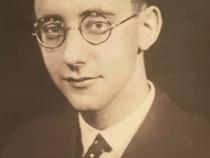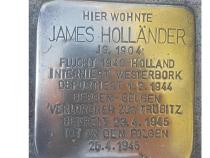James was born in 1904 as the son of Rechel and Mendel Holländer Junior. His father had an egg marketing business in Berlin. James worked in real estate. James then married Anny Weissberg from Köln and, on the 11 of June 1935, their daughter Rachel was born.
On the 1st of December 1938, their son, Samuel was born in Berlin. Horrified by the events of the Kristallnacht, Anny and James decided to seek a safer place for their children. Rachel was sent to a foster family in the Netherlands and three weeks after Samuel’s birth Anny left with him for the Netherlands as well.
James stayed in Berlin. Towards the end of 1939, the Nazis knocked on James’s door, in Altonaer Strasse number 6. They came to take him away. He told them that he was going to pack a suitcase and ran away through the back door. He tried to enter the Netherlands but because he didn’t have German citizenship he was arrested and sent to jail. Whilst there, he met other Jews in a similar situation. James used to give them history lectures. After some time, James managed to get out of prison and escaped to Antwerp, Belgium. He stayed in Antwerp until the Nazis invaded Belgium. In May 1940, he entered the Netherlands illegally, and joined Anny and the children in Leeuwarden.
James, being illegal, was unable to work, so he spent most of his time at the public library. One day, at the library, his wallet was stolen. After emptying the wallet, the thieves threw the wallet away. The police found the wallet, arrested James, and sent him to the Police transit camp in Westerbork in the Northeastern part of the Netherlands. By now, the Nazis had occupied the Netherlands as well. From the mid-1940s to July 1942, James was confined in Westerbork along with other German Jews.
In July 1942 the Nazis decided to use Westerbork as a transition camp - Dutch Jews were to be transported to the camp, spend anywhere between a few days to some months, and then be sent to extermination camps. The German Jews that were already at the camp were put to work by the Nazis to manage the camp and organize the transportation of Dutch Jews. In July 1942, Anny and the children joined James in Westerbork. They were allowed to live together so James and Anny both worked in the camp.
Anny, James and the children stayed in Westerbork until they were sent to Bergen Belsen in February 1944. They were brought to the Sternlager - the star camp, where prisoners wore yellow star patches on their clothing instead of the camp uniform. The conditions were harsh. Men and women were separated and placed in big barracks. Food was scarce. Regardless of the weather, the prisoners had to stand outside between 4-5 hours every day. James and Anny had to work. James had to dig out wood roots from the frozen ground and Anny had to disassemble shoes. As time went by, diseases spread around the camp. James and Samuel were infected with Typhoid.
On 10th of April 1945, five days before Bergen Belsen was liberated by the British, James, Anny, and the children, along with 2500 prisoners, were ordered to board a train. Destination: Theresienstadt. The journey continued for days. The train had to change route due to allied bombing until its final stop outside the village of Tröbitz in Brandenburg.
On the 23rd of April, Soviet soldiers freed the train. Of the prisoners, 198 were already dead, from malnutrition and disease, and 320 additional people would die due to exhaustion and disease.
James died in Tröbitz on the 25th of April 1945, at the age of 40.




